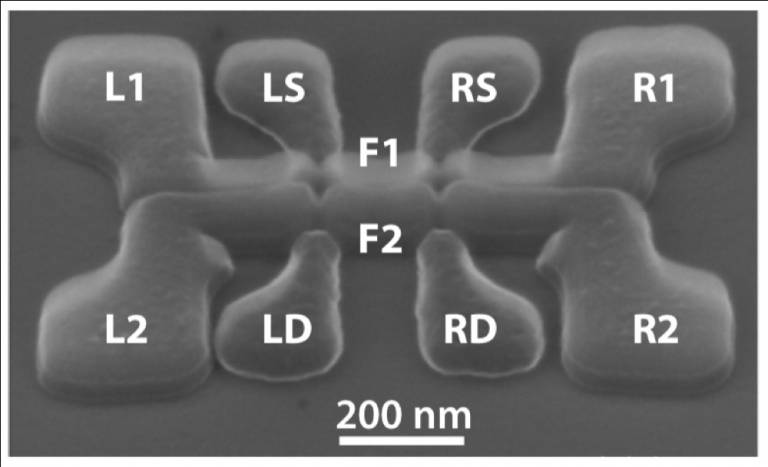Research opens potential route to couple qubits across separate silicon nanowires
18 September 2020
UCLQ-led team in collaboration with CEA-Leti present a quantum device with an integrated “floating” gate nanostructure that extends the sensitivity range of a single capacitive sensor.

Quantum computers promise to solve some of the most challenging computational problems, such as revolutionising communications and the search for new materials, chemicals and medicines.
However, to tackle the most demanding computational simulations, it is thought that a large-scale fault-tolerant quantum computer might ultimately require 10 million quantum bits (qubits) - a much larger number than current technology can support.
Quantum engineers at UCLQ, and elsewhere, work on the challenge of scaling up the number of qubits available on quantum devices. Spin qubits formed in silicon quantum dot devices are one of the promising candidates for large-scale quantum computing.
Director of UCLQ, Professor John Morton says: “Silicon electronics has already transformed our society over the past decades, and it has huge potential to deliver the scalable platform that can realise the most profound impacts of quantum computing.”
Many scaled quantum computing approaches are based on arrays of quantum dots. Silicon nanowires are a promising candidate for producing quantum dot architectures that use common fabrication methods. However, as a wire, they naturally produce chains of quantum dots in a single dimension – along the axis of the nanowire. To scale-up this nanowire-based technology, a process through which the otherwise isolated nanowires can be coupled together must be developed.
Research, published recently in Nano Letters, led by the Quantum Spins Dynamics (QSD) team of UCLQ, has detailed a quantum device with an integrated “floating” gate nanostructure that opens up the possibility of coupling qubits on isolated nanowires.
The team along with their collaborators at CEA-Leti have shown how a ‘floating gate’ coupler between silicon nanowires can be used to dramatically enhance the operational range of a single electron box charge sensor.
Corresponding author, UCLQ Research Fellow Dr Michael Fogarty, said: “Our team have combined experimental measurements of couplings between pairs of quantum dots of varying separation across a range of devices, with cryo-SiMOS simulations used to create a full picture of the sensitivity decay. We found that electrostatic couplings mediated by the floating gate could be used to achieve spin readout for distances up to 500 nm without a reduction in readout contrast.”
To date, semiconductor spin qubits have been implemented in one-dimension quantum dot arrays. These 1-D set-ups require substantially more computational resources to implement error correction schemes for fault-tolerant quantum computing. The production of two-dimensional quantum dots arrays, that are easily fabricated using current methods will reduce this computational resource demand making silicon nanowires a more promising platform for future scalable semiconductor spin qubits.
Corresponding author, Jingyu Duan and student of the EPSRC Centre for Doctoral Training in Delivering Quantum Technologies said: “Our results provide a critical ingredient for efficiently coupling qubits distributed across separate silicon nanowires. This could become a crucial element for scaling a highly promising route of the Fully Depleted Silicon On Insulator (FD-SOI) qubit platform into a second dimension.”
This research was funded by the UK Engineering and Physical Sciences Research Council and the European Union’s Horizon 2020 research and innovation programme.
Links:
- Read the full paper in Nano Letters
- Visit the website of the Quantum Spin Dynamics Group
Contact:
Henry Bennie, UCLQ Business Development and Communications Manager
Image:
Oblique-angle scanning electron micrograph illustrating the gate structure of the double nanowire device coupled by two floating gates. (Credit: Nano Lett. 2020, 20, 10, 7123–7128)
 Close
Close

